Canadian East Coast
-
- CANADIAN EAST COAST OFFSHORE SERVICE VESSELS-EXPERIENCES AND PROBABLE FUTURE REQUIREMENTS Maritime Reporter, Jun 1981 #50
The supply and anchor-handling vessels that are deployed on the east coast of Canada are basically a transfer of equipment, technology and experience that evolved in the northern parts of the North Sea in the middle to later 1970s. The North Sea as a whole tends to compare environmentally with the east coast of Canada as f a r as supply boat operators are concerned. The northern parts of the North Sea are similar to those off Newfoundland and the southern part of the North Sea.
Anchor-handling/supply vessels were becoming to be recognized as an integral part of the North Sea exploration activity by the late 1960s. Their appearance was coincidental with the use of the semisubmersible d r i l l i n g rigs.
These rigs required to be towed from one drilling site to another, and each site had its particular anchor pattern. The support vessels were used for transporting supplies, towing and anchor handling.
The early vessels engaged for these tasks were of modest horsepower (2,000-3,000) and encountered difficulty in anchor handling because of the low horsepower. It often required two vessels working together to drag out the anchor chains and place anchors.
As drilling programs moved to deeper waters by the early 1970s, vessels of 4,000 to 6,000 horsepower were appearing in order to provide the required support services and h a n d l e g r e a t er lengths of chain and cable.
The North Sea area soon became dominated by Norwegianbuilt vessels that demonstrated that the northern areas of the North Sea required vessels of 7,000 to 8,000 bhp and with greater freeboard. By 1978 a few vessels with over 9,000 horsepower were appearing, and shipyards responded to the required new capacity and capability of anchorhandling/ supply vessels. By now the low-horsepower vessels were obsolete except for the purpose of supply only.
By the mid 1970s the charter rates reflected the change in vessel technology and demand, and many shipyards were capitalizing on the situation. There has been a steady climb in charter rates that reflect a reasonable spread between horsepower categories.
Unfortunately, this reasonably encouraging situation did not last.
By 1975, the oil and exploration activities on a worldwide basis entered a downturn. This was caused by various factors, most of which were related to international politics. By 1978, however, a full-scale recovery was being experienced, which for Canada's east coast was extremely exciting.
Now, again through political disputes between levels of government and an apparent unacceptable national energy policy by some oil companies, we are in a reduced stage of exploration. The effect that politically motivated alterations of policy with respect to energy is serious and plays havoc with industrial growth and to the attainable objective of this nation's energy self-sufficient position.
In view of the uncertainty facing oil companies in the exploration activities, it is not surprising that over the past few years very few vessels of any p a r t i c u l ar horsepower class have been built, and there are now no vessels at all available.
Based on our operations, commencing in 1979 with 14 OSA vessels, we are satisfied t h a t these vessels have performed reasonably well in our waters. These vessels range from 146 to 258 feet long with horsepowers ranging from 4,000 to 13,000, and deadweight tonnages from 936 to 2,480.
The horsepower for east coast support vessel operations appears to be in the 8,000 range with additional specifications and reserve capabilities requiring up to 13,000 horsepower. Along with this horsepower r a n g e , ice-strengthened hulls are required for ice and the heavy seas frequently encountered.
Fuel consumption for vessels in this range could amount to as much as 20 tons per day, and with the present and expected cost of fuel, consideration must be given in designing vessels for the utmost economy.
For ease of maneuvering and especially in the "hover" situation, which occurs frequently under quite extreme weather conditions, joystick control is considered a standard. This single control, through an analog control system, transmits the required signal and thrust strength to the main p r o p e l l e r s , bow thrusters and rudders. The next control development will be a requirement for automatic digital computer control using radar reference to maintain the distance from the rigs when loading or discharging personnel or goods.
There is, however, some general opposition to this system because of the danger of the captain becoming less alert in his monitoring role rather than being physically responsible for the position of the vessel.
Weather-protected triple-drum and closed winches are now being favored over double-drum systems.
This is to facilitate the additional pendant wire for deep waters, and thus, increases the speed of the anchor-handling activity.
There is also a trend toward deeper vessels that would permit 5 to 6 feet of freeboard and the capability of carrying 1,200 to 15,000 tons of cargo.
It does not appear conceptually possible to have one vessel designated that will meet all requirements.
However1 the paper does give an outline specification for a vessel that the authors feel would come as close as possible to the ideal vessel to operate off Canada's east coast.
This vessel has a length of 64 meters overall, a breadth of 14 meters, a depth of 7 meters, and a loaded draft of 6 meters with a deadweight of 1,400 metric tons.
The bollard pull would be 120 metric tons. Propulsion would be provided by two diesel engines having a continuous rating of 8,000 bhp total and a total maximum rating of 8,800 bhp.
In addition to the features listed in these specifications, the following recommendations are suggested, based on the authors' experience, using the basic vessel as the 8000 type OSA: 1. Increase the brake horsepower to 8,000 bhp/120 tons bollard pull (preferably four 2,000 bhp engines with two engines on one gear box).
2. Increase the draft and wat e r / f u e l c a p a c i t y (interchangeable tanks) (100-150 cubic meters of more water would be sufficient).
3. Increase freeboard by 0.30 to 0.50 meters.
4. W i t h i n c r e a s e d d r a f t , a stronger bow thrust unit will be necessary.
5. Cooling water outlet to return outboard and to the seachest (to keep clear f r om ice) with two-way valve.
6. Thermal oil boiler for heating device (preferably steam) to be big enough to heat water tanks, void spaces, s e a c h e s t s, vent pipes and bilges. If steam, connections to be fitted on deck for deicing with flexible steam hose.
7. Vessel to be ice strengthened with icebreaking capability.
8. Bridge windows to have defrosting capability and the bridge to have two separate heating systems, i.e., steam and electric, with each system with the capacity to provide sufficient heat.
9. If avoidable, vessel should not have lifeboats but instead liferafts, to be installed in a place protected from freezing spray (behind the funnels) or releasing device to be heated. If lifeboats are necessary, the boats and davits should both be heated.
10. One storage winch to be capable of accommodating 1,200 meters of polypropylene rope for iceberg towing.
11. Avoid all unnecessary rails, wire stays, m a s t and a e r i a l s, sounding pipes, vent pipes, etc., on the forecastle and forward structure.
12. Winch room to be heated.
13. B e s i d e s air-conditioning, each cabin/messroom should have separate heating systems (steam/ electric).
14. Deep-sea mooring to be limited to one winch.
-
- Design Semisubmersible For Use In Arctic Ice Conditions Maritime Reporter, Oct 1981 #48
. Mr. McLean reported recently that four major oil companies and two drilling contractors had expressed interest for possible use on the Canadian east coast and other Arctic locations where offshore drilling is limited to the ice-free season. The design, dubbed the "Ice Maiden," calls for a
-
- Halifax Lays Keel For First of Two OSV's Maritime Reporter, Jun 2002 #91
are similar to Atlantic Eagle and Atlantic Hawk - both of which were built at the yard in 1999. They are currently deployed in support of the Canadian East Coast offshore oil industry. Measuring 262 x 59 x 22 ft. (80 x 18 x 6.6 m), the vessels will have four main engines, each at 4,000 kW, which will give
-
- Third Rowan Gorilla Drilling Rig Delivered By Marathon LeTourneau Maritime Reporter, Feb 15, 1985 #28
Rotterdam. The journey took approximately 20 days, and brought the rig from the Gulf of Mexico around the Florida peninsula and up the U.S. and Canadian east coast to Nova Scotia. During the voyage the tug received propulsion assistance from the operation of the Gorilla Ill's twin 112-inch propellers
-
- 38th Annual CSSRA Conference And First Canadian Shipbuilding & Offshore Exhibition Maritime Reporter, Jan 15, 1986 #12
, editor, Doig's Digest and president, Ian M. Doig & Associates Ltd. "Fracture Control Plan in the Fabrication of Offshore Structures for the Canadian East Coast," by Denis Larose, head, Welding & Metallurgical Department, Versatile Davie Inc. 12 Noon: Lunch. 2:00 pm: "Building Canada's Frontier— The
-
- CRUISE SHIPPING '91 Conference & Exhibition Maritime Reporter, Jan 1991 #20
as Antigua- Barbuda, Bonair, British Virgin Islands, Curacao, Freeport and Nassau, Bahamas, Martinique and Curacao. Another informal group, the Canadian East Coast/St. Lawrence Seaway ports, will also be exhibiting. Not to be overlooked, Cruise Shipping's conference has been expanded as well. A number
-
 )
March 2024 - Marine Technology Reporter page: 45
)
March 2024 - Marine Technology Reporter page: 45ronments. The new agreement will address speci? c techni- cal gaps in the UUV defense and offshore energy markets especially for long duration, multi-payload mission opera- tions where communications are often denied or restricted. As part of the new alliance, Metron’s Resilient Mission Autonomy portfolio
-
 )
March 2024 - Marine Technology Reporter page: 33
)
March 2024 - Marine Technology Reporter page: 33regulated industry in the world.” How- ever, commercial success depends on many factors, not least a predictable OPEX. Over the past four years, SMD has worked with Oil States Industries to calculate cost per tonne ? gures for prospective customers. Patania II uses jet water pumps to Oil States’
-
 )
March 2024 - Marine Technology Reporter page: 9
)
March 2024 - Marine Technology Reporter page: 9from marinas along the western coast. The exact number of lizing laser detection systems can detect mines just below the mines, as well as their locations, remains largely a mystery, surface, even those hiding in murky water. The Airborne Laser although reports suggest that over three hundred have been
-
 )
March 2024 - Marine Technology Reporter page: 4
)
March 2024 - Marine Technology Reporter page: 4Editorial NIWA-Nippon Foundation TESMaP/ Rebekah Parsons-King www.marinetechnologynews.com ast month marked the resounding NEW YORK 118 E. 25th St., New York, NY 10010 return of Oceanology Interna- Tel: (212) 477-6700; Fax: (212) 254-6271 tional in London, perennially one Lof the world’s most important
-
 )
April 2024 - Maritime Reporter and Engineering News page: 27
)
April 2024 - Maritime Reporter and Engineering News page: 27RADM PHILIP SOBECK, MILITARY SEALIFT COMMAND With COVID, we had to make some hard choices for our Do your CIVMARs have upward mobility? mariners because we couldn’t rotate. Many of our mariners The Navy has Sailors who become “Mustangs,” and work found other employment, and were able to use their skills
-
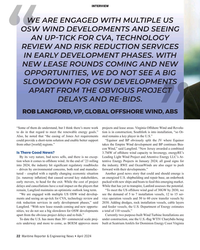 )
April 2024 - Maritime Reporter and Engineering News page: 22
)
April 2024 - Maritime Reporter and Engineering News page: 22INTERVIEW WE ARE ENGAGED WITH MULTIPLE US OSW WIND DEVELOPMENTS AND SEEING AN UP-TICK FOR CVA, TECHNOLOGY REVIEW AND RISK REDUCTION SERVICES IN EARLY DEVELOPMENT PHASES. WITH NEW LEASE ROUNDS COMING AND NEW OPPORTUNITIES, WE DO NOT SEE A BIG SLOWDOWN FOR OSW DEVELOPMENTS APART FROM THE OBVIOUS
-
 )
April 2024 - Maritime Reporter and Engineering News page: 18
)
April 2024 - Maritime Reporter and Engineering News page: 18MARKETS & gas activity returns, we anticipate that supply of the vessels The Question of Emissions to offshore wind projects will reduce, driving demand for ad- Given that SOVs and CSOVs operate in a segment target- ditional CSOVs. ing reduced emissions, and many operate in the North Eu- Outside of China
-
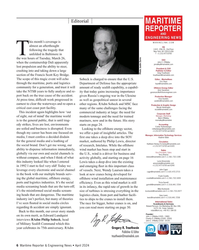 )
April 2024 - Maritime Reporter and Engineering News page: 6
)
April 2024 - Maritime Reporter and Engineering News page: 6Editorial MARITIME REPORTER AND ENGINEERING NEWS his month’s coverage is M A R I N E L I N K . C O M almost an afterthought HQ 118 E. 25th St., 2nd Floor following the tragedy that New York, NY 10010 USA T +1.212.477.6700 Tunfolded in Baltimore in the wee hours of Tuesday, March 26, CEO John C.
-
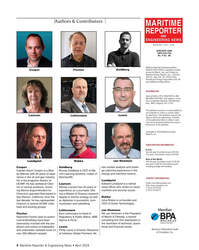 )
April 2024 - Maritime Reporter and Engineering News page: 4
)
April 2024 - Maritime Reporter and Engineering News page: 4Authors & Contributors MARITIME REPORTER AND ENGINEERING NEWS M A R I N E L I N K . C O M ISSN-0025-3448 USPS-016-750 No. 4 Vol. 86 Maritime Reporter/Engineering News (ISSN # 0025-3448) is published monthly Cooper Fischer Goldberg except for March, July, and October by Maritime Activity Reports, Inc.
-
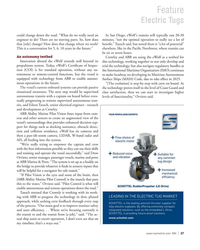 )
April 2024 - Marine News page: 37
)
April 2024 - Marine News page: 37Feature Electric Tugs could change down the road. “What do we really need an In San Diego, eWolf’s transits will typically run 20-30 engineer to do? There are no moving parts. So, how does minutes, “not the optimal operation to really see a lot of that [role] change? How does that change where we work?
-
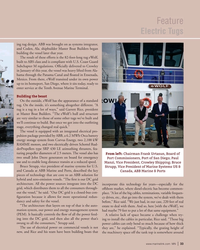 )
April 2024 - Marine News page: 33
)
April 2024 - Marine News page: 33Feature Electric Tugs ing tug design. ABB was brought on as systems integrator, and Coden, Ala. shipbuilder Master Boat Builders began building the vessel later that year. The result of these efforts is the 82-foot-long tug eWolf, built to ABS class and is compliant with U.S. Coast Guard Subchapter M
-
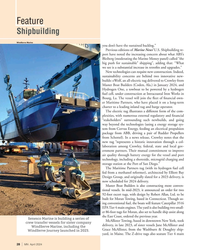 )
April 2024 - Marine News page: 28
)
April 2024 - Marine News page: 28Feature Shipbuilding WindServe Marine you don’t have the sustained backlog.” Previous editions of Marine News’ U.S. Shipbuilding re- port have noted the increasing concern about what ABS’s Bleiberg (moderating the Marine Money panel) called “the big push for sustainable” shipping”, adding that: “What we
-
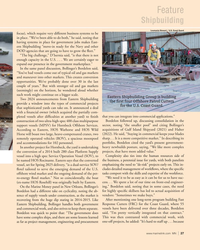 )
April 2024 - Marine News page: 27
)
April 2024 - Marine News page: 27Feature Shipbuilding Loumania Stewart / U.S. Coast Guard focus), which require very different business systems to be in place. “We’ve been able to do both,” he said, noting that having systems in place for government jobs makes East- ern Shipbuilding “move-in ready for the Navy and other DOD agencies
-
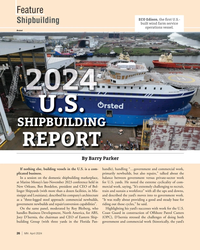 )
April 2024 - Marine News page: 26
)
April 2024 - Marine News page: 26Feature ECO Edison, the ? rst U.S.- Shipbuilding built wind farm service operations vessel. Ørsted U.S. SHIPBUILDING REPORT By Barry Parker If nothing else, building vessels in the U.S. is a com- handle), handling “…government and commercial work, plicated business. primarily newbuilds, but also
-
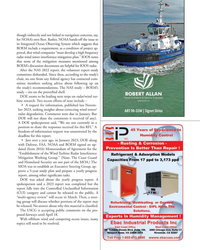 )
April 2024 - Marine News page: 25
)
April 2024 - Marine News page: 25though indirectly and not linked to navigation concerns, say, for NOAA’s own ? eet. Rather, NOAA hands-off the issue to its Integrated Ocean Observing System which suggests that BOEM include a requirement, as a condition of project ap- proval, that wind companies “must develop a high frequency radar
-
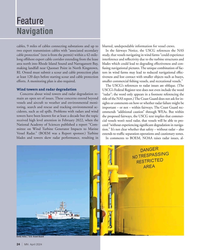 )
April 2024 - Marine News page: 24
)
April 2024 - Marine News page: 24Feature Navigation cables, 9 miles of cables connecting substations and up to blurred, undependable information for vessel crews. two export transmission cables with “associated secondary In the fairways Notice, the USCG references the NAS cable protection” (text is from the permit) within a 42-mile-
-
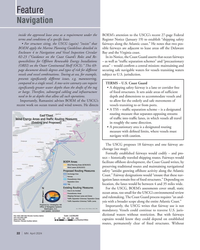 )
April 2024 - Marine News page: 22
)
April 2024 - Marine News page: 22Feature Navigation inside the approved lease area as a requirement under the BOEM’s attention to the USCG’s recent 27-page Federal terms and conditions of a speci? c lease. Register Notice (January 19) to establish “shipping safety • For structure siting, the USCG (again) “insists” that fairways along
-
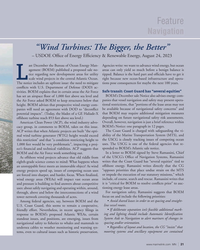 )
April 2024 - Marine News page: 21
)
April 2024 - Marine News page: 21Feature Navigation “Wind Turbines: The Bigger, the Better” – USDOE Of? ce of Energy Ef? ciency & Renewable Energy, August 24, 2023 ast December the Bureau of Ocean Energy Man- Agencies write: we want to advance wind energy, but ocean agement (BOEM) published a proposed sale no- areas can only yield so
-
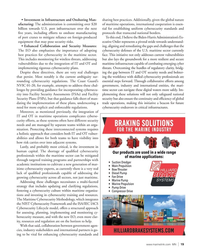 )
April 2024 - Marine News page: 19
)
April 2024 - Marine News page: 19• Investment in Infrastructure and Onshoring Man- sharing best practices. Additionally, given the global nature ufacturing: The administration is committing over $20 of maritime operations, international cooperation is essen- billion towards U.S. port infrastructure over the next tial for establishing
-
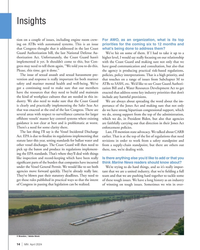 )
April 2024 - Marine News page: 14
)
April 2024 - Marine News page: 14Insights tion on a couple of issues, including engine room crew- For AWO, as an organization, what is its top ing on ATBs with automated systems. This is an issue priorities for the coming six to 12 months and that Congress thought that it addressed in the last Coast what’s being done to address them? Gua
-
 )
April 2024 - Marine News page: 13
)
April 2024 - Marine News page: 13Q&A We’ve still got some work to do. Despite the new guid- Looking across the industry, what are some ance, we are seeing differences in the way that the Coast other important regulatory issues that AWO is Guard is applying crewing and life-saving requirements to currently paying attention to? ATBs from
-
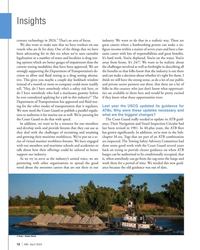 )
April 2024 - Marine News page: 12
)
April 2024 - Marine News page: 12Insights century technology in 2024.” That’s an area of focus. industry. We want to do that in a realistic way. These are We also want to make sure that we have workers on our great careers where a hardworking person can make a six- vessels who are ? t for duty. One of the things that we have ? gure
-
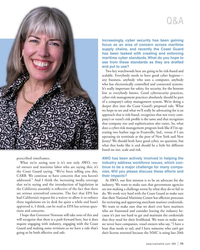 )
April 2024 - Marine News page: 11
)
April 2024 - Marine News page: 11Q&A Increasingly, cyber security has been gaining focus as an area of concern across maritime supply chains, and recently the Coast Guard has been tasked with creating and enforcing maritime cyber standards. What do you hope to see from these standards as they are drafted and put to use? Two key
-
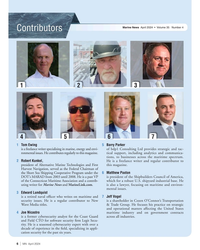 )
April 2024 - Marine News page: 6
)
April 2024 - Marine News page: 6Marine News April 2024 • Volume 35 Number 4 Contributors 1 2 3 5 4 6 7 1 Tom Ewing 5 Barry Parker is a freelance writer specializing in marine, energy and envi- of bdp1 Consulting Ltd provides strategic and tac- ronmental issues. He contributes regularly to this magazine. tical support, including
